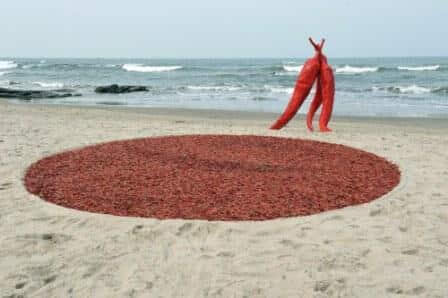Indian artist Subodh Kerkar at Sculpture by the Sea 2012
 The use of spices maybe the most distinguishing feature of Indian cuisine, but did you know, the spiciest of the spices, chilli, is not native to India.
The use of spices maybe the most distinguishing feature of Indian cuisine, but did you know, the spiciest of the spices, chilli, is not native to India.
“It was the Portuguese who brought the chilli to India to trade it with other spices,” Indian artist Subodh Kerkar says. “Not many people even in India know that chillies are not indigenous to our cuisine”.
Chillies came to India from South America via the Portuguese somewhere in the beginning of 16th Century. Today India is the largest producer of chillies in the world.
Subodh’s sculpture The Chilly, in this year’s Sculpture by the Sea (SbyS) exhibition, is a silent reminder of this history. It is part of his new series of works which celebrates the role of the ocean as a vehicle of cultural diffusion.
Sydney’s iconic outdoor sculpture exhibition has attracted many Indian artists over the years. Last year’s Indian Coco-Cola by Rajesh Sharma, depicting tender coconuts for sale on a battered bicycle, created much interest among both Indian and mainstream visitors.
This year the magnificent red hot chilli, measuring 220 cm X 40 cm X 40 cm, is sure to stand out along the famed coastal walk this year. It was selected from among 500 submissions from 24 countries, included in the final list of just over a hundred sculptures.
“The work is not just about the commodity,” reveals Subodh. “It connects at various subliminal levels of history”.
Interesting to note is the texture of the installation: a layered outer structure has been created with tyre skin, on a fibre glass inner structure.
“When you use recycled material for work, you are reviving its history,” describes Subodh. “The material’s earlier life as a truck tyre, having travelled miles across the country, complements the story of the chilli having travelled across continents”.
The 53-year-old Goa-based Subodh Kerkar centres so much of his work around the ocean that it is surprising he has not exhibited at SbyS before, at which water-based themes are common.
Born and brought up in a seaside town, he spent much time observing not only the mannerisms of the water, but also of humans and animals around it. Even his very words are tinged with nautical implications. He wrote once, for example, “My artistic journey is full of many voyages I have ventured on, discovering new islands. Like Columbus, I perhaps discovered islands I did not intend to discover. Sometimes I thought I had discovered an island which later I realized was not an island at all! Nevertheless the voyages are fascinating and full of adventure and bliss”.
His earliest installation The Tenth Planet was a serendipitous project that brought Kerkar to this artform from painting (yes, he started off painting ‘sea’ scenes). In The Tenth Planet he dug large pits on a Goa beach, placed copper bowls in the centre with electric bulbs underneath, and illuminated them at dusk. The effect was stupendous – and a landscape artist was born. Subodh gave up a career as a medical practitioner to delve full-time into art, landscape sculpture in particular.
Following the success of The Tenth Planet, Kerkar worked similarly on beach installations of cones of sand lit with concealed bulbs, giant bamboo lamps, palm leaves, old boats and coir ropes, even hundreds of mussel shells.
In Unfolding of a Dream, he famously used Tibetan flags. Nearly 600 flags, lungtas as they are called, were installed on the cliffs as though they were walking down, and then congregating on the beach sands. It was Kerkar’s way of offering support to the Tibetan struggle, “the ocean praying for the freedom of the snow”. The red, yellow and orange flags were not only a stunning sight to behold, they also touched a chord in the Tibetan community: two hundred monks staged a torch march among the flags.
“The ocean is my master and my muse,” Kerkar says of his works.
As one critic notes, in Kerkar’s art, “the sea is both outside and inside, form and material, subject as well as object.”
Even the restaurant he runs in Goa is called, what else, Waves.
The tyre material used to create The Chilly has been a recent passion. He discovered it at a trinket shop in Jaipur selling artworks made from it, and its richness appealed to him. In his first work with it, he created a camel’s foot, to draw parallels with the traditional Rajasthani mode of transport and its more modern counterpart. Again, in Turtle, he created a slow-moving animal with fast-moving tyres.
Kerkar is known equally for his social and political activism as he is for his environmentalism. The social relevance of his art comes out loud and clear as he uses newsprint to cover trees (to draw attention to the issue of deforestation), lines the sides of streets with saris to make a comment on the plight of traditional artisans, creates an “anti-corruption table” (with nails underneath!), and plants Goan rice saplings in Lisbon Portugal, in a pattern depicting Vasco da Gama’s sea route to India, to “sprout ancient memories”. A work in progress, unique in its political message, will be located partly in India and partly in Pakistan.
Comment on his prolific creativity, and he will respond, in his trademark ‘ocean’ terms: “If you watch the sea waves, you will realise that most of them wet the already wet sand. Yet every once in a while comes a wave that wets new, dry sand. My father always said to me – be like that wave”.
Sculpture by the Sea is on along the Bondi to Tamarama cliff walk, 18 Oct – 4 Nov 2012.
Frankey Gerard Fernandes and Rajni Anand Luthra





